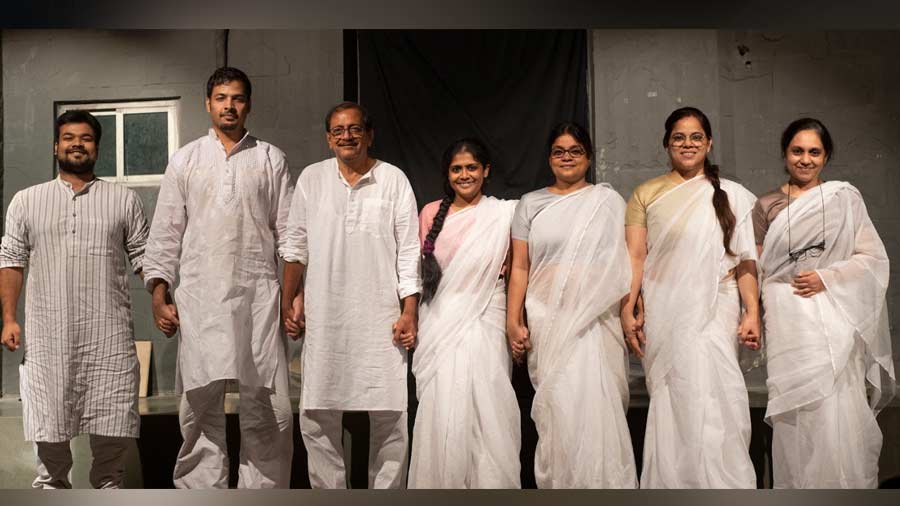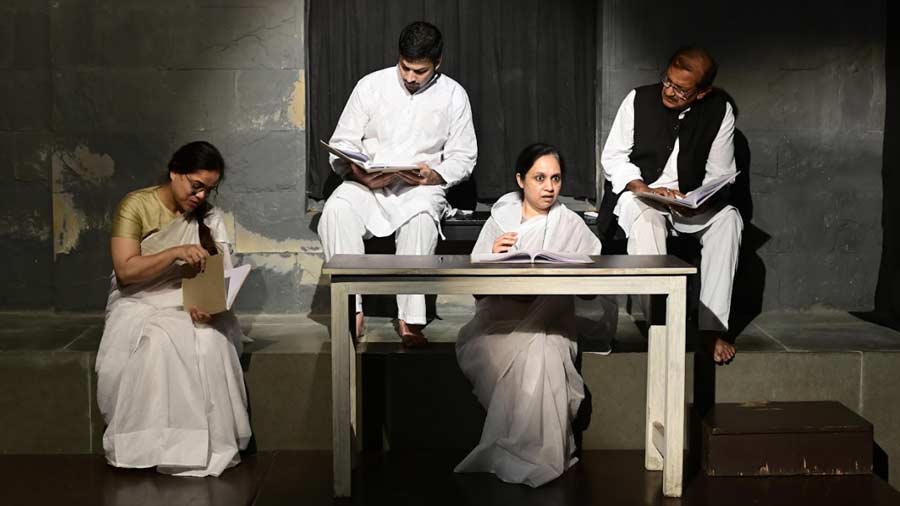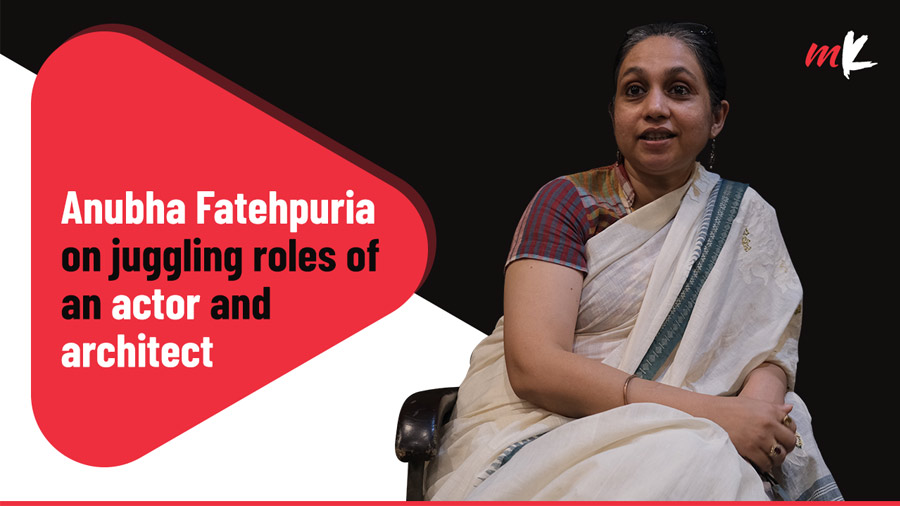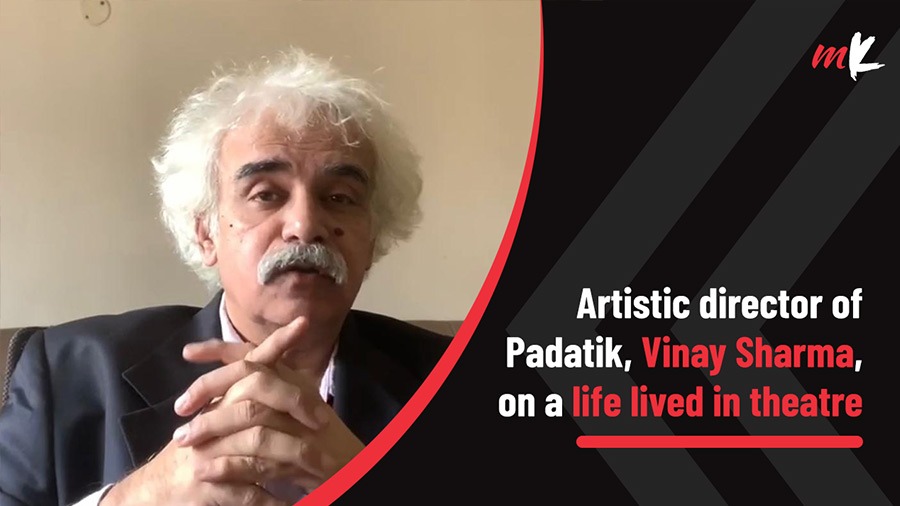The idea of Kaagaz ke Gubbare was born out of dramatised readings of Ismat Chughtai’s works. I began to explore her writings and see where it would take me, as opposed to having a definite idea of the nature of a theatrical production. I felt that while my actors dramatised the written word during the readings, the text would ‘communicate’ to me the proposed treatment. When committed actors read — for pleasure — there comes a moment when one says: “What if we…“ That is when interesting possibilities emerge. In our case, a theatrical production of the dramatised readings emerged as the logical outcome that became Kaagaz ke Gubbare.
The reading process was necessary to discover the various layers in Ismat Chughtai’s writings. It would have been one thing to translate what she had written into a dramatised performance. But there was a secondary layer: what one read between the lines was discerned only when one was collectively reading, analysing and discussing. I handpicked a couple of actors to read together with me about 15 of her plays and mazmoons (essays) across biweekly sittings to enter Ismat’s mind and the worlds of her characters. The result was a shortlist of six short stories and a few mazmoons from which I extracted and judiciously blended to create the framework of the six stories that made up Kaagaz ke Gubbare.
This reading experience prompted the distinctive takeaway that zindadil Ismat Chughtai was not writing from a perch; she was talking to every single one of us, cackling along the way with her eyes sparkling; she was asking the women particularly with ‘Tumne khud ke liye kya kiya?’ These words encapsulate all she is asking the women of her time (and subsequent decades). My take on these words: it is easy for women to blame men for the patriarchy of the centuries and it is easy for women to say ‘He was responsible for my misery’ and then you come across these words by Ismat that effectively cross-question: ‘What did you do to improve your circumstances? What did you do to make your world better? What did you do to improve the lot of other women?’
The last line was — and is — deeply relevant. If you read Ismat, you will realise that on most occasions, the cause of one woman’s disempowerment is another woman, usually a relative within the family. This is brought out in Kaagaz ke Gubbare; the dadi advises Mirza to divorce his wife with the words “Usay talaaq de do” and “Jahan jootekari se kaam ho jaye wahan nikaah ki kahan gunjaish”. It is remarkable how little has changed in eight decades. Ismat continues to be relevant, which, in turn, makes Kaagaz ke Gubbare relevant.

'I began to explore her (Ismat Chughtai) writings and see where it would take me'
Pain finds a voice
I extracted portions from Ismat’s writings by retaining the conversational flavour. I retained her words (or else it would have become my interpretation of her writings). What we presented is a condensed version of her writings without deviating in soul or spirit. The words she used in her works are the words we have used, so what one gets is the flavour of the language (Urdu) she crafted as well as her spirit.
The storyline and Ismat’s alfaaz represent the framework around which I innovated: one, I gave our actors (selectively) a handheld script — not as much as an aid to memory as much to remind all that the words were not ours but those of Ismat Chughtai; two, we were reading from them and that our creativity was really in how we conveyed those words through speech or body language; three, we reversed the theatre configuration: the place where the audience would conventionally sit was turned into a narrow ‘stage’ and vice versa — if only to accentuate that the ‘ghutan’ (suffocation) of this strip was really the only manouvreing space that most women find in life and how she resourcefully turns even this into a space from where she provides for her family, herself and the world; four, there was a feeling among some that the audience would not be able to sit through six stories and 100 minutes without an interval (the audience didn’t think so); five, there was a feeling also among some that perhaps pricing a ticket at Rs 200 for a dramatised reading was prohibitive — but I wanted to stick to both 100 mins and Rs 200 a ticket and happily for us the doubts were proved wrong by the audiences; six, we were limited by the fact that we could draw only from the Ismat we could find in the Devanagri script; seven, we stripped away the peripherals down to a minimalist treatment — no make-up for the artistes and virtually no props on stage except for a table and bench — that may have been questioned by some in the conventional theatre.

The cast went through a reading process to discover the various layers in Ismat Chughtai’s writings
The public response has been outstanding; we had completed six shows by the end of November 2022 with mostly word-of-mouth publicity. The last two shows comprised a full seating house and two durries out to accommodate the spillover — we had people sitting on the floor. Why has the production done well? I think because our audience resonated with the fact that these were stories on women and by women (writer, director and most actors) as opposed to most women’s stories written by men. The play touched a nerve on collective women’s pain accumulated across the centuries.

'The play touched a nerve on collective women’s pain accumulated across the centuries'
The romance and the rationale
The best part of the play is the Urdu. The sheer romance of listening to someone use the right alfaaz (word) to spin a good story. For 100 minutes, as one of our audience members movingly said, this was a chance to soak the magic of a rich language; another said that she saw three of our six shows and on the third occasion, she shut her eyes to only listen to the words that reminded her of the zubaan spoken by her mother and grandmother; yet another person hugged and wept before leaving with the words “Just beautiful”.
We retained the richness of the Urdu without seeking to dumb it down. There were specific words like ‘barjastagoi’ that most would have missed, so we created a parallel narrative where we quickly explained the meaning and moved back to the original. Did this confuse the audience? I don’t think so. The audience got used to the rich embroidery of words — the few words leading to the actual word gave the sentence a direction, so they got the import of what the word stood for. It also helped the audience graduate its understanding rather than providing everything on a plate.

There is minimum use of props, just a bench and a table
There are a number of Ismat’s turns of phrase one can live on, where she says nothing and yet says a lot. There is this sequence when Madan tells her sister that Sunder chala gaya (he has left) and asks if she should follow him to Delhi; the sister replies “Jaao meri balaa se jahannum me” and the next Ismat line is “Woh jahannum ki taraf ud gayi” (implying that she flew to be with hell/her lover). Or when Madan says: “Tum nahi jaanti” and Ismat writes in the form of a reply that “Main nahi jaan sakti”. There are such instances of a nuanced play of words. This occurs right through Ismat’s writings, which we retained in the script.
The rationale of the lines Kaagaz ke Gubbare? The ‘kaagaz’ part came from her essay Kaagazi Hai Pairahan and that paper can indicate a fragility of the female condition. The ’gubbare‘ came from an analogy: it is only when you ignite the fanoosh (lighted lantern) does it rise into the sky. Similarly, only when you ignite the woman of substance — as we believe most women are — will she graduate to the next level.
(As told to Mudar Patherya)


